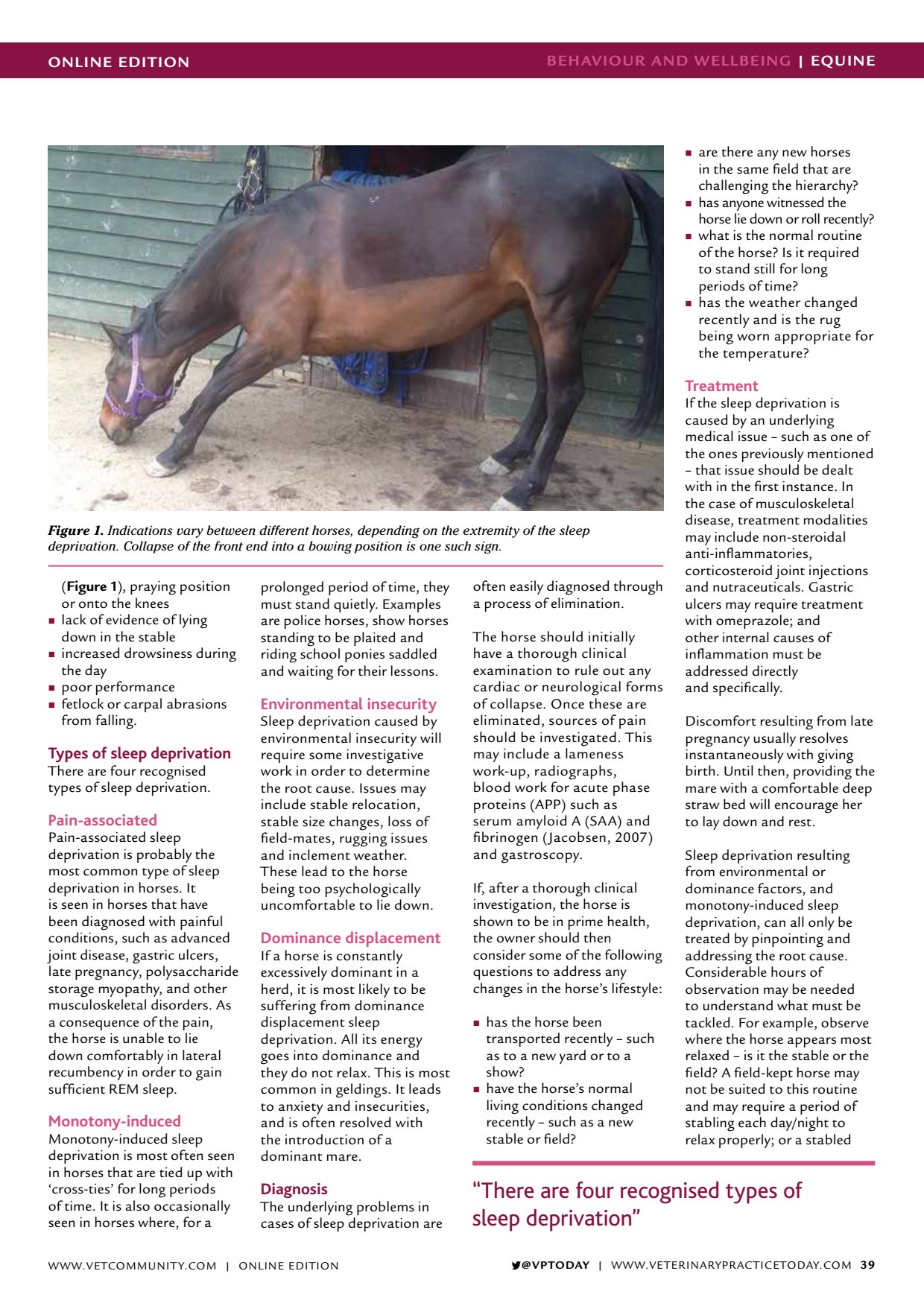Types sleep deprivation
ONLINE EDITION BEHAVIOUR AND WELLBEING | EQUINE VPTODAY | WWW.VETERINARYPRACTICETODAY.COM 39 ( Figure 1 ), praying position or onto the knees lack of evidence of lying down in the stable increased drowsiness during the day poor performance fetlock or carpal abrasions from falling. Types of sleep deprivation There are four recognised types of sleep deprivation. Pain-associated Pain-associated sleep deprivation is probably the most common type of sleep deprivation in horses. It is seen in horses that have been diagnosed with painful conditions, such as advanced joint disease, gastric ulcers, late pregnancy, polysaccharide storage myopathy, and other musculoskeletal disorders. As a consequence of the pain, the horse is unable to lie down comfortably in lateral recumbency in order to gain sufficient REM sleep. Monotony-induced Monotony-induced sleep deprivation is most often seen in horses that are tied up with cross-ties for long periods of time. It is also occasionally seen in horses where, for a prolonged period of time, they must stand quietly. Examples are police horses, show horses standing to be plaited and riding school ponies saddled and waiting for their lessons. Environmental insecurity Sleep deprivation caused by environmental insecurity will require some investigative work in order to determine the root cause. Issues may include stable relocation, stable size changes, loss of field-mates, rugging issues and inclement weather. These lead to the horse being too psychologically uncomfortable to lie down. Dominance displacement If a horse is constantly excessively dominant in a herd, it is most likely to be suffering from dominance displacement sleep deprivation. All its energy goes into dominance and they do not relax. This is most common in geldings. It leads to anxiety and insecurities, and is often resolved with the introduction of a dominant mare. Diagnosis The underlying problems in cases of sleep deprivation are often easily diagnosed through a process of elimination. The horse should initially have a thorough clinical examination to rule out any cardiac or neurological forms of collapse. Once these are eliminated, sources of pain should be investigated. This may include a lameness work-up, radiographs, blood work for acute phase proteins (APP) such as serum amyloid A (SAA) and fibrinogen (Jacobsen, 2007) and gastroscopy. If, after a thorough clinical investigation, the horse is shown to be in prime health, the owner should then consider some of the following questions to address any changes in the horses lifestyle: has the horse been transported recently such as to a new yard or to a show? have the horses normal living conditions changed recently such as a new stable or field? are there any new horses in the same field that are challenging the hierarchy? has anyone witnessed the horse lie down or roll recently? what is the normal routine of the horse? Is it required to stand still for long periods of time? has the weather changed recently and is the rug being worn appropriate for the temperature? Treatment If the sleep deprivation is caused by an underlying medical issue such as one of the ones previously mentioned that issue should be dealt with in the first instance. In the case of musculoskeletal disease, treatment modalities may include non-steroidal anti-inflammatories, corticosteroid joint injections and nutraceuticals. Gastric ulcers may require treatment with omeprazole; and other internal causes of inflammation must be addressed directly and specifically. Discomfort resulting from late pregnancy usually resolves instantaneously with giving birth. Until then, providing the mare with a comfortable deep straw bed will encourage her to lay down and rest. Sleep deprivation resulting from environmental or dominance factors, and monotony-induced sleep deprivation, can all only be treated by pinpointing and addressing the root cause. Considerable hours of observation may be needed to understand what must be tackled. For example, observe where the horse appears most relaxed is it the stable or the field? A field-kept horse may not be suited to this routine and may require a period of stabling each day/night to relax properly; or a stabled Figure 1. Indications vary between different horses, depending on the extremity of the sleep deprivation. Collapse of the front end into a bowing position is one such sign. There are four recognised types of sleep deprivation WWW.VETCOMMUNIT Y.COM | ONLINE EDITION
